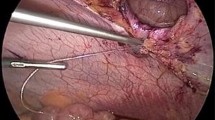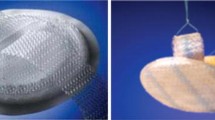Abstract
Introduction
With approximately 1 million ventral and inguinal hernia repairs performed in the United States each year, even small rates of complications translate into large numbers of patients. Less invasive approaches that potentially lower morbidity deserve consideration, recognizing there are many technical considerations that currently limit their use. We describe a reproducible technique and lessons learned in our laboratory that answer some existing questions with regards to the use of NOTES® for hernia repair.
Methods
A non-survival porcine model with general anesthesia was utilized in all cases. Each animal underwent transgastric peritoneal access with a percutaneous endoscopic gastrostomy (PEG) technique, and the gastrotomy was dilated with a wire-guided balloon dilatation catheter. An Esophageal Z-stent delivery device (Cook Medical, Winston-Salem, NC) was modified ex-vivo to allow us to introduce and protect a 10 × 15 cm lightweight polypropylene hernia prosthetic with pre-placed sutures. Once deployed, the sutures were pulled through the abdominal wall using a looped spinal needle technique in combination with the flexible endoscope. After the four anchoring sutures were tied, proprietary endoscopically placed tacks (Cook Medical) were placed at regular intervals between the sutures to secure the edges of the prosthetic.
Results
Hernia repairs were performed on five animals. In each case, we successfully completed prosthetic delivery and deployment into the peritoneal cavity, anchoring to the abdominal wall with full-thickness abdominal wall sutures, and endoscopically placed nitinol tacks. All prosthetics were deployed flat against the anterior abdominal wall. Operative times ranged from 65 to 120 min.
Conclusion
Transgastric abdominal wall hernia repair is feasible, consistent, and reproducible. In particular, the delivery system can successfully deliver the prosthetic across the gastric wall via a transoral route. Survival animal experiments investigating outcomes related to quality of repair, microbiology, adhesions, and visceral closure need to be done. Human studies are not recommended until these issues are formally investigated.




Similar content being viewed by others
References
Rutkow I (2003) Demographics, socioeconomic aspects of hernia repair in the United States in 2003. Surg Clin North Am 83(5):1045–1051
Desilets DJ, Romanelli JR, Earle DB, Surti VC, Willingham FF, Brugge WR (2009) Loop-anchor purse-string vs. endoscopic clips for gastric closure—a NOTES™ comparison study using burst pressures. Gastrointest Endosc 70(6):1225–1230 (Epub 2009, Oct 20)
Earle D (1999) A simple and inexpensive technique for closing trocar sites and grasping sutures. J Laparoendosc Adv Surg Tech A 9(1):81–85
Bhat YM, Hedge S, Knaus M, Solomon J, Kochman ML (2009) Transluminal endosurgery: novel use of endoscopic tacks for the closure of access sites in natural orifice transluminal endoscopic surgery (with videos). Gastrointest Endosc 69(6):1161–1166
Palanivelu C, Rajan PS, Rangarajan M, Parthasarathi R, Senthilnathan P, Prasad M (2008) Transvaginal endoscopic appendectomy in humans: a unique approach to NOTES-world’s first report. Surg Endosc 22(5):1343–1347 (Epub 2008 Mar 18)
Palanivelu C, Rajan PS, Rangarajan M, Parthasarathi R, Senthilnathan P, Praveenraj P (2008) Transumbilical flexible endoscopic cholecystectomy in humans: first feasibility study using a hybrid technique. Endoscopy. 40(5):428–431
Romanelli JR, Desilets DJ, Earle DB (2008) Pancreatic pseudocystgastrostomy with a peroral, flexible stapler: a human NOTES™ anastomosis in two patients. Gastrointest Endosc 68(5):981–987
Marescaux J, Dallemagne B, Perretta S, Wattiez A, Mutter D, Coumaros D (2007) Surgery without scars: report of transluminal cholecystectomy in a human being. Arch Surg 142(9):823–827
Bessler M, Stevens PD, Milone L, Parikh M, Fowler D (2007) Transvaginal laparoscopically assisted endoscopic cholecystectomy: a hybrid approach to natural orifice surgery. Gastrointest Endosc 66(1):1243–1245
Branco FAJ, Noda RW, Kondo W, Kawahara N, Rangel M, Branco AW (2007) Initial experience with hybrid transvaginal cholecystectomy. Gastrointest Endosc 66(6):1245–1248
Dolz C, Noguera JF, Martín A, Vilella A, Cuadrado A (2007) Transvaginal cholecystectomy (NOTES) combined with minilaparoscopy. Rev Esp Enferm Dig 99(12):698–702
Forgione A, Maggioni D, Sansonna F, Ferrari C, Di Lernia S, Citterio D, Magistro C, Frigerio L, Pugliese R (2008) Transvaginal endoscopic cholecystectomy in human beings: preliminary results. J Laparoendosc Adv Surg Tech A. 18(3):345–351
Zorrón R, Filguerias M, Maggioni LC, Pombo L, Lopes Carvalho G, Lacerda Oliveira A (2007) NOTES transvaginal cholecystectomy: report of the first case. Surg Innov 14(4):279–283
Zorrón R, Maggioni LC, Pombo L, Oliveira AL, Carvalho GL, Filgueiras M (2008) NOTES transvaginal cholecystectomy: preliminary clinical application. Surg Endosc 22(2):542–547
Zornig C, Mofid H, Emmermann A, Alm M, von Waldenfels HA, Felixmüller C (2008) Scarless cholecystectomy with combined transvaginal and transumbilical approach in a series of 20 patients. Surg Endosc 22(6):1427–1429
Jacobsen GR, Thompson K, Spivack A, Fischer L, Wong B, Cullen J, Bosia J, Whitcomb E, Lucas E, Talamini M, Horgan S (2010) Initial experience with transvaginal incisional hernia repair. Hernia 14(1):89–91 (Epub 2009 Apr 15)
Hu B, Kalloo AN, Chung SS, Cotton PB, Gostout CJ, Hawes RH, Pasricha PJ, Isakovich NV, Nakajima Y, Kawashima K, Kantsevoy SV (2007) Peroral transgastric endoscopic primary repair of a ventral hernia in a porcine model. Endoscopy 39:390–393
Miedema BW, Bachman SL, Sporn E, Astudillo JA, Thaler K (2009) Transgastric placement of biologic mesh to the anterior abdominal wall. Surg Endosc 23(6):1212–1218 (Epub 2009 Mar 5)
Sherwinter DA, Eckstein JG (2009) Feasibility study of natural orifice transluminal endoscopic surgery inguinal hernia repair. Gastrointest Endosc 70(1):126–130 (Epub 2009 Feb 27)
Lomanto D, Dhir U, So JBY, Cheah WK, Moe MA, Ho KY (2009) Total transvaginal endoscopic abdominal wall hernia repair: a NOTES survival study. Hernia 13:415–419
Hagen ME, Wagner OJ, Swain PC, Patel A, Inan I, Pugin F, Fasel J, Morel P (2009) Transrectal natural orifice transluminal endoscopic surgery for umbilical hernia repair in a human cadaver (with video). Gastrointest Endosc 69(6):e53–e54 (Epub 2009 Jan 18)
Bellón JM, Contreras LA, Buján J (2000) Ultrastructural alterations of polytetrafluoroethylene prostheses implanted in abdominal wall provoked by infection: clinical and experimental study. World J Surg 24(5):528–532
Gumargalieva KZ, Moiseev YV, Daurova TT, Voronkova OS (1982) Effects of infections on the degradation of polyethylene terephthalate implants. Biomaterials 3(3):177–180
Kelly ME, Behrman SW (2002) The safety and efficacy of prosthetic hernia repair in clean-contaminated and contaminated wounds. Am Surg 68(6):524–529
Blatnik J, Jin J, Rosen M (2008) Abdominal hernia repair with bridging acellular dermal matrix—an expensive hernia sac. Am J Surg 196(1):47–50 (Epub 2008 May 7)
Fong DG, Ryou M, Pai RD, Tavakkolizadeh A, Rattner DW, Thompson CC (2007) Transcolonic ventral wall hernia mesh fixation in a porcine model. Endoscopy 39(10):865–869
Buck L, Michalek J, Van Sickle K, Schwesinger W, Bingener J (2008) Can gastric irrigation prevent infection during notes mesh placement? J Gastrointest Surg 12(11):2010–2014 (Epub 2008 Aug 13)
Oh DS, Manning MM, Emmanuel J, Broyles SE, Stone HH (2002) Repair of full-thickness defects in alimentary tract wall with patches of expanded polytetrafluoroethylene. Ann Surg 235(5):708–712
Author information
Authors and Affiliations
Corresponding author
Rights and permissions
About this article
Cite this article
Earle, D.B., Desilets, D.J. & Romanelli, J.R. NOTES® transgastric abdominal wall hernia repair in a porcine model. Hernia 14, 517–522 (2010). https://doi.org/10.1007/s10029-010-0701-0
Received:
Accepted:
Published:
Issue Date:
DOI: https://doi.org/10.1007/s10029-010-0701-0




